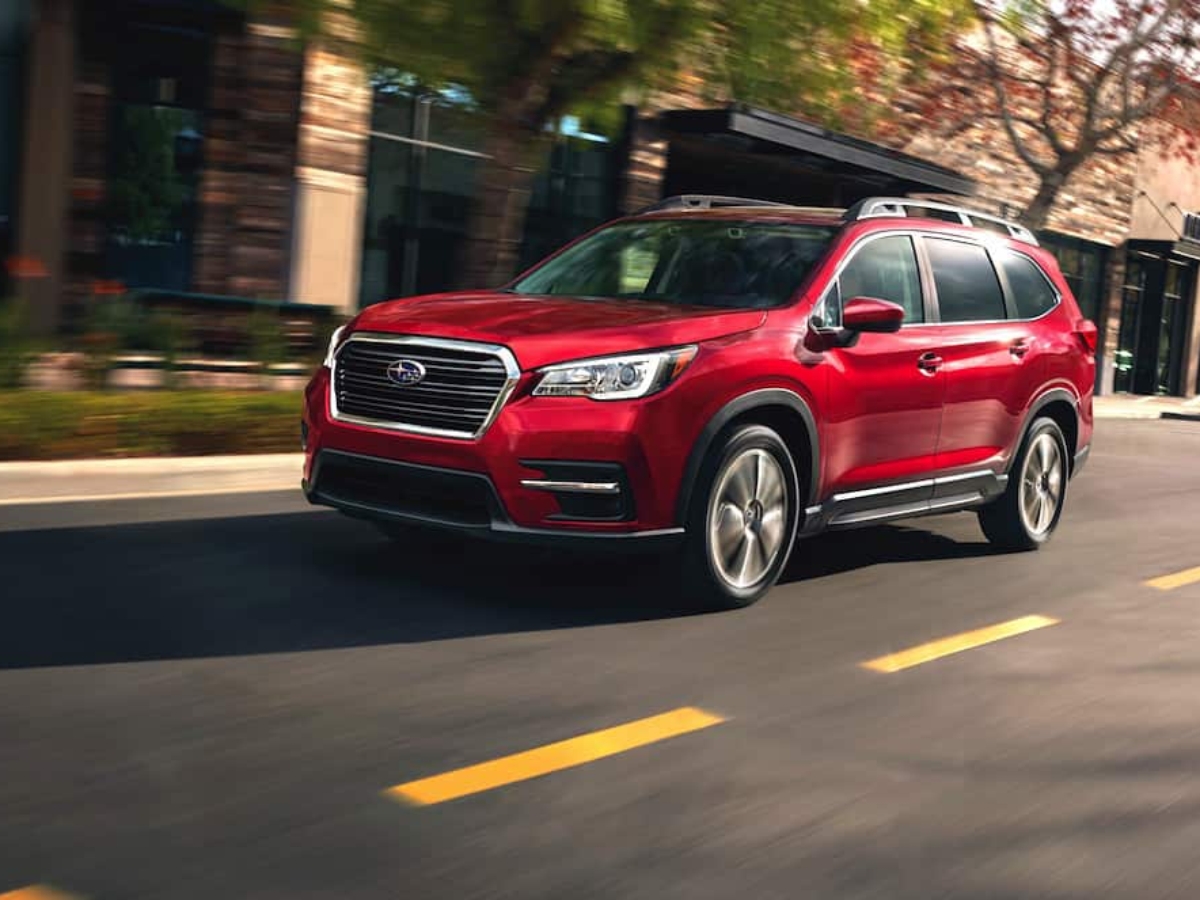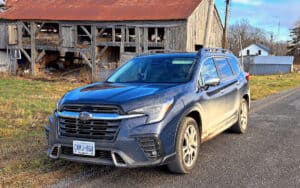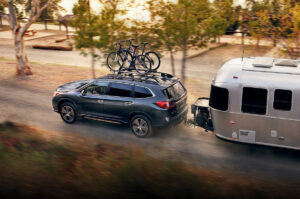Editor’s Note: All photos of the 2019 Ascent Limited trim level
Mid-size SUVs with three-row seating are a major market in North America but Subaru, an auto maker with more SUV credibility than most, has been without a contender in the space since the demise of the slow-selling Tribeca in 2014. The new Ascent aims to plug that gap – and give Subaru drivers, who are a loyal bunch, no reason to defect to a rival brand when their families grow beyond the capacity of a Forester or Outback.
Subaru Ascent Line-Up and Price
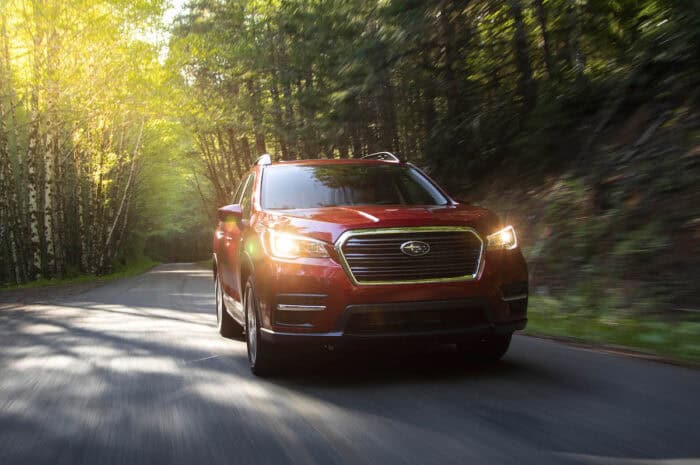
Canada: The 2019 Ascent comes configured for seven or eight passengers and is available in Canada in four trim levels: Convenience, Touring, Limited, and Premier, ranging in price from $35,995 to $49,995. All feature the same turbocharged Boxer engine and AWD. We spent a week with the Limited in a seven-passenger configuration with second-row captain’s chairs, which retail for C$46,995.
US: Note that in the US, the four-model range runs from Ascent (US$31,995) through Premium and Limited to the top-spec Touring (US$44,695). US pricing below, starting MSRP less any charges/fees:
- Ascent – US$31,995
- Ascent Premium – US$34,195
- Ascent Limited – US$38,995
- Ascent Touring – US$44,695
Exterior Styling

Creating a memorable, aerodynamically efficient design for what is essentially a large, high-riding box without compromising practicality or putting off conservative buyers is no easy task. A further challenge for the new Ascent is that it has no direct predecessor upon which to draw. The Forester and even the newer Crosstrek have distinctive looks that can be modernized and improved upon with each new iteration, but this first-generation Ascent must establish itself both within the Subaru range and a crowded SUV market.
To our eyes, the result is a mixed bag. It’s a pleasant-looking vehicle and there are elements of grown-up Forester to the Ascent’s styling, such as the trapezoidal grille and kicked-up rear window line as it reaches the C-pillar. But truthfully, we’re not sure whether, if we removed the badges, we could tell that it was a Subaru, as opposed to one of its Japanese competitors.
Interior Space
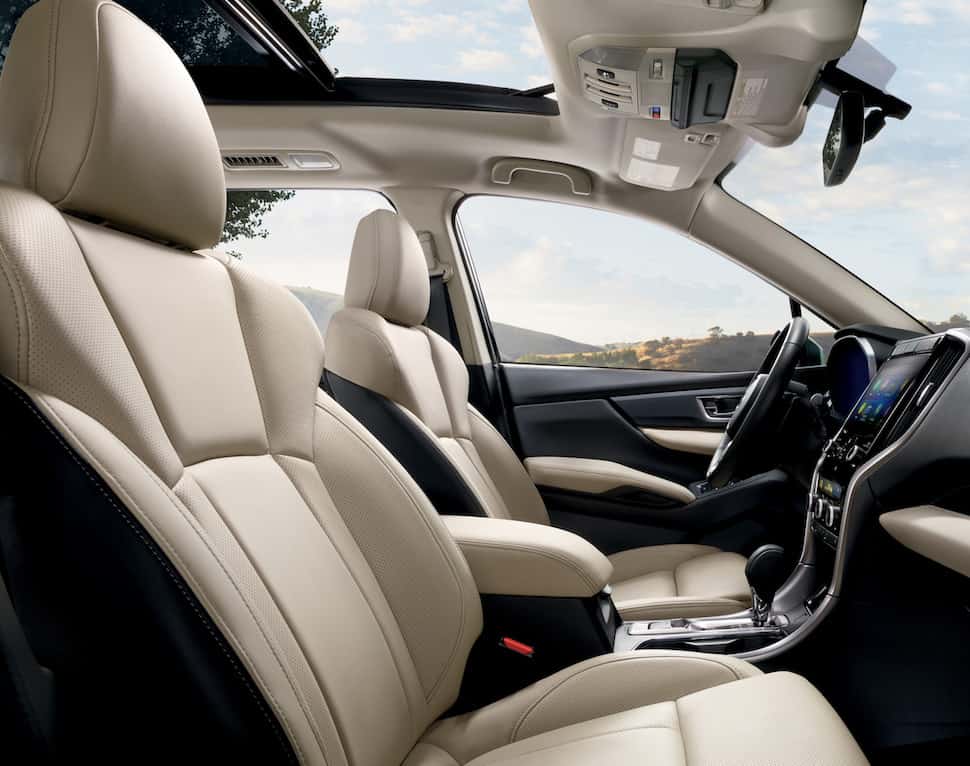
The Ascent is a big car in Subaru’s terms – it’s the largest ever, in fact. At 4,998mm long, 2,176mm wide and 1,819mm high, the newcomer is 174mm longer, 111mm wider and 139mm higher than an Outback, which Subaru markets as a mid-size SUV but is truly a crossover wagon. You’ll certainly notice that extra bulk when you squeeze it into your garage, but the Ascent’s size is right on the money for the class, being 7mm longer than a Honda Pilot and 39mm shorter than a Volkswagen Atlas (reviewed here), for example. It falls between the two in wheelbase, too.
The dimensions translate into generous interior space for first and second-row occupants, particularly with the second-row captain’s chairs tested here. Those comfortable, heated armchairs ease access to the third row, too, which – as is usually the way – offers good accommodation for children but would be less appealing for adults on long journeys.
Where the Ascent doesn’t score so well is in luggage capacity. Our initial suspicion that the trunk was a little short on space was borne out in another comparison with the Pilot and Atlas. With all the seats in place, the cargo capacity is 504L (Ascent), 524L (Pilot), and 583L (Atlas). With the third row folded flat, the figures are 1,345L (Ascent), 1,583L (Pilot) and 1,572L (Atlas). The sill is high for loading, too. No three-row SUV offers the outright space for people and luggage of a dedicated minivan, but the Ascent’s trunk space is disappointing in and of the same.
Related – 7 Changes to the Refreshed 2023 Subaru Ascent 3-Row SUV
Cabin and Equipment

The Ascent’s cabin is comfortable, well-finished, and mostly quiet (unless you have kids in the back). Fortunately, there are dedicated rear HVAC controls – with a neat override function from the front – and enough USB ports and drinks holders to help to keep the noise down. Like the front-seat occupants, the kids will appreciate the smart leather trim of upscale models like our Limited, although the folds in the trim on the seat cushions make it hard to clean out crumbs that the kids leave behind.

Up front, the environment is mostly familiar, in a good way, with Subaru’s usual dashboard elements and two-screen layout helping graduates from the brand’s smaller vehicles feel right at home. The Limited gets an 8.0in touchscreen-based infotainment system with the usual Starlink smartphone integration, GPS, Apple CarPlay/Android Auto connectivity and a 14-speaker Harman Kardon audio setup.
Above the main screen sits a 6.3in multifunction display for, among other things, notifications from the EyeSight driver-assistance package. The latter was mostly unobtrusive, but the lane keep assist doesn’t always keep the Ascent centred in the lane as well as, say, the Honda system.
Engine and Transmission
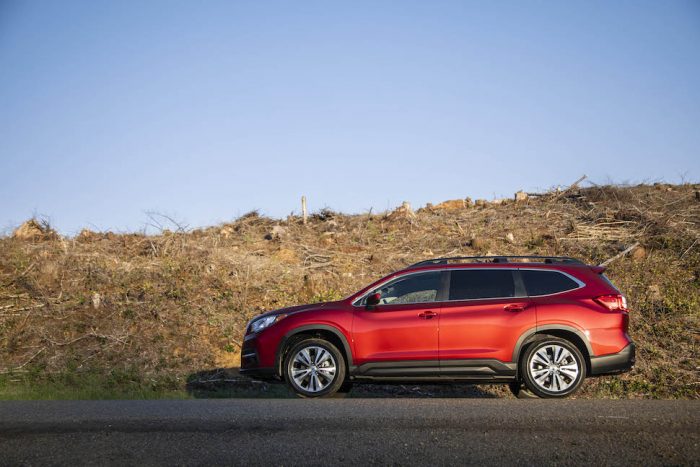
- Engine: 2.4-liter turbocharged flat-four (H4)
- Horsepower: 260 hp @ 5,600 rpm
- Torque: 277 lb-ft @ 2,000 rpm
- Transmission: Continuously Variable Transmission (CVT) with manual mode
- Drivetrain: All-Wheel Drive (AWD)
- Towing Capacity: Up to 5,000 pounds
All Ascents are powered by a new, 2.4-liter, turbocharged derivative of Subaru’s latest-generation, direct-injected Boxer engine family. It makes 260 horsepower and 277 lb-ft of torque. By way of comparison, that’s 16 fewer horses than the Atlas and 20 less than the Pilot, but 11 lb-ft more torque than either’s V6 can muster.
Engine numbers are less important than whether the engine does the job it’s designed to do, however. There will always be those who want their family transport to perform like a rocket ship, or indeed prefer the smoothness of a bigger-capacity V6, but we feel that the Ascent’s turbo-H4 motor provided perfectly adequate power for an SUV of this size. It isn’t tuned for performance but still provides a pleasant, Subaru-esque inlet noise under acceleration, too.
Ultimately, however, we’re not sure that the Ascent stands out in enough areas to challenge the class best. Its cargo capacity is a little on the tight side and we’re not convinced that the 2.4 turbo/CVT combo will hold universal appeal, particularly as we struggled to deliver the promised fuel economy benefits.
We were less enamoured with its fuel economy, or with the transmission to which it’s coupled. It’s not the fact that we only managed 13L/100km (18mpg) in a week of mixed-use in cold conditions – that number is pretty normal for this type of vehicle. The problem is the gulf to Ascent’s official consumption figures – 11.6L/100km (20mpg) in the city and 9L/100km (20mpg) on the highway.
Downsized turbo engines have a habit of drinking substantially more fuel in the real world than they do on official test cycles, and we suspect that the Ascent’s smaller motor has to work harder than a larger-capacity V6 to get the job done.
We felt that the Lineartronic CVT transmission (which also has paddle shift controls, should you ever feel the need) did the Ascent no favours, either. It whines when it’s cold, the simulated shifts are jerky under harder acceleration and it simply lacks the smoothness and unobtrusiveness of the best torque-converter automatics. Given that there appears to be no real-world fuel economy benefit, we’re not sure it’s the right choice for this vehicle.
Related – 2023 Subaru Ascent First Drive Review
Driving Impressions

Powertrain aside, the Ascent is an adequate performer on the road. We could have used a little more plushness on the roughest surfaces, but the ride, for the most part, is smooth and quiet, even on the Limited’s sizable, 20-inch rims. The only real let-down was the steering, which for our money is too light and lacks that confidence-giving on-centre feel.
Off-road, it’s hard to imagine any of the class rivals holding a candle to the Ascent. We had the opportunity to take the Ascent around a punishing off-road course, which it dispatched with barely a murmur.
If regular off-road use will factor in your Ascent ownership, you’ll want to know that the ground clearance is 220mm. Again, for comparison purposes, that’s a useful 35mm more than the Pilot or 17mm more than the Atlas. In addition, every model bar the Convenience will tow 2,270kg (just over 5,000 lb), which aligns with the rivals.
Takeaway
Pro
- Subaru families can grow with the brand
- Strong off-road performance
- Attractive, spacious passenger accommodation
Cons
- Generic exterior styling
- Gap between official and real-world fuel consumption
- CVT transmission a let-down
The Subaru Ascent has been coming for a long time and, much like the Volkswagen Atlas, extends the brand’s range into new and potentially lucrative territory. It’s gratifying to know that Subaru has hit this most mainstream market with a vehicle that stays true to its DNA: Boxer engine, standard AWD and standout off-road performance.
Subaru likes to play the unconventional alternative to mainstream brands. The Ascent is a solid entry into the mid-size, three-row market and will certainly appeal both to buyers who’ve loved their smaller Subies and to newcomers looking for something a little different from the ubiquitous Nissan Pathfinders and Toyota Highlanders.
Ultimately, however, we’re not sure that the Ascent stands out in enough areas to challenge the class best. Its cargo capacity is a little on the tight side and we’re not convinced that the 2.4 turbo/CVT combo will hold universal appeal, particularly as we struggled to deliver the promised fuel economy benefits.


